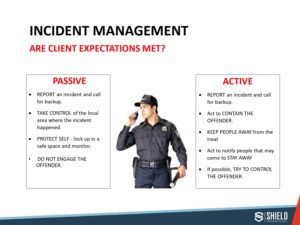Security operators are faced with a daily dilemma that may not be that apparent:
What would be my roles and duties if a severe incident happened? What should I do when confronted with an aggressive offender?
Security operators’ roles are usually stagnant, lack innovation, and are mostly repetitive.
Most of the emphases of clients and employers are around prevention of confrontation, leading to the prevention of an incident. Security operators are mostly expected to take a contain and de-escalate approach to managing incidents – this is all well and true. Still, it results in having staff that effectively know only to do that.
When Security operators are confronted with real violent situations, the lack of training and customer service approach can cause an internal conflict between their need to act and their embedded default need to de-escalate.
Clients have their perspectives of what a security officer can do. Clients see the security guards as “ultimate responsibilities and abilities” as emergency operators. In most cases
The client expects a security operator to handle all threats, even ones he has not encountered and trained for before.
This gap leads security operators to an almost inevitable failure.
Many employers and clients have a PASSIVE approach to handling a threat; it is based on a few steps:
- REPORT an incident and call for backup.
- TAKE CONTROL of the local area where the incident happened.
- PROTECT SELF – lock up in a safe space and monitor.
- DO NOT ENGAGE THE OFFENDER.
We favour an ACTIVE approach that gives the security operator initiative and an ability to make decisions:
- REPORT an incident and call for backup.
- Act to CONTAIN THE OFFENDER.
- KEEP PEOPLE AWAY from the treat
- Act to notify people that may come to STAY AWAY
- If possible, TRY TO CONTROL THE OFFENDER.
This change of approach needs to be reflected across the board, starting from recruiting appropriate personnel, going into their basic training, site induction, SOP, and any training provided.
If we want security operators to manage an incident successfully – give them the proper guidance and show them how it’s done. 
